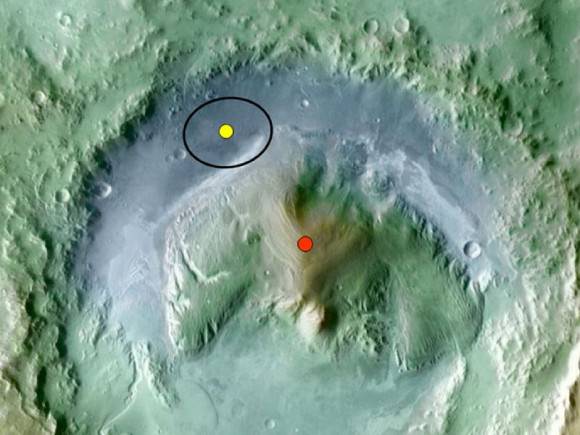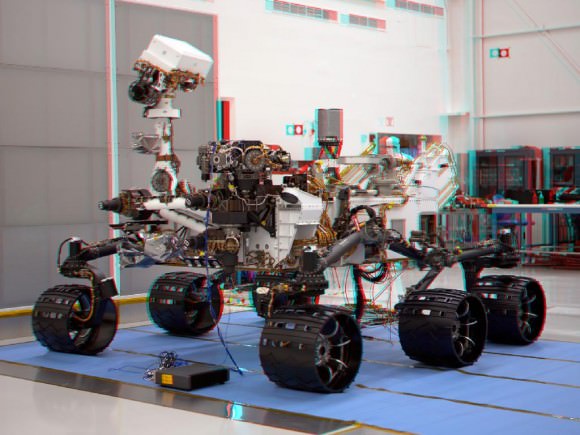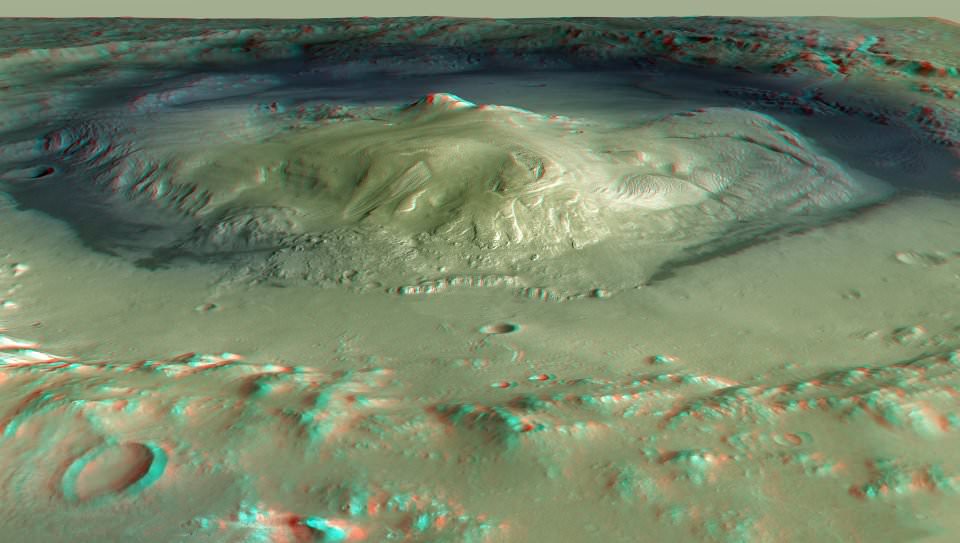[/caption]
Curiosity, NASA’s next Mars rover is on target to launch this Saturday, Nov 26 from the Florida Space Coast in less than four days at 10:02 a.m. NASA is utilizing a first-of- its- kind pinpoint landing system for targeting Curiosity to touchdown inside Gale Crater – one of the most scientifically interesting locations on the Red Planet because it exhibits exposures of clay minerals that formed in the presence of neutral liquid water that could be conducive to the genesis of life.
For a dramatic glimpse of the ragged and richly varied terrain of the 154 kilometer (96 mile) wide Gale Crater check out the glorious 3 D stereo image above. Another 3 D image, below, shows Curiosity being tested at NASA’s Jet Propulsion Laboratory (JPL) in Pasadena. Calif., earlier this year.
“From NASA’s prior missions we’ve learned that Mars is a dynamic planet,” said Michael Meyer, lead scientist for NASA’s Mars exploration program, at a pre-launch briefing for reporters at the Kennedy Space Center.
“We’ve learned that it has a history where it was warm and wet at the same time that life started here on Earth. And we know it’s undergone a massive transition from that more benign time to what it is today.”
“Mars is worth exploring because of the potential for its having been habitable, at least in its past,” said Meyer.
Gale crater is dominated by a layered mountain rising some 5 km (3 mi) above the crater floor, readily apparent in the images above and below.

Color coding in this image of Gale Crater on Mars represents differences in elevation. The vertical difference from a low point inside the landing ellipse for NASA's Curiosity Mars Science Laboratory (yellow dot) to a high point on the mountain inside the crater (red dot) is about 3 miles (5 kilometers). Credit: NASA
“Liquid water was not short term in the past on ancient Mars. It has a role in carving out channels and depositing sediments in the past within craters that were carried by the water,” said Bethany Ehlmann of NASA’s Jet Propulsion Laboratory in Pasadena, Calif, at the briefing.
“Clays and carbonates are minerals that form in the presence of liquid water. The presence of clays in particular indicate the long-term presence of water interacting with the rocks and causing alteration of minerals. Clays also have water in their chemical structure as hydrates.”
NASA is targeting a landing ellipse – 20 by 25 kilometers (12.4 miles by 15.5 miles) – located in the northern portion of Gale and visible in the foreground.
The landing site was selected from some 60 candidates by the science team and NASA because it features an alluvial fan likely formed by water-carried sediments containing the clay minerals and is highlighted in another image below.
The lower layers of the nearby mountain — within driving distance for Curiosity — contain clay minerals and sulfates indicating a wet history on ancient Mars.
“Gale Crater is about as big as the Los Angeles basin,” said MSL project scientist John Grotzinger of JPL and Caltech, at the briefing. The mountain in the middle is as high as Mt Whitney, the tallest mountain in the lower 48 US states.”
“Over the course of the mission me might be about to go to the top of the nearby mound. At the base of the mound we see strata that are composed of clays.
“In one location, we can drive the rover through all these successive different environments and sample these different periods in Martian history,” explained Grotzinger.
All systems are “GO” at this time and the weather outlook currently looks favorable for an on time liftoff of Curiosity atop an Atlas V rocket from Space Launch Complex 41.

This stereoscopic anaglyph image was created from a left and right stereo pair of images of the Mars Science Laboratory mission's rover, Curiosity. The scene appears three dimensional when viewed through red-blue glasses with the red lens on the left. The image was taken May 26, 2011, in Spacecraft Assembly Facility at NASA's Jet Propulsion Laboratory in Pasadena, Calif. The mission is scheduled to launch during the period Nov. 26 to Dec. 18, 2011, and land the rover Curiosity on Mars in August 2012. Credit: NASA/JPL-Caltech
Complete Coverage of Curiosity – NASA’s Next Mars Rover launching 26 Nov. 2011
Read continuing features about Curiosity by Ken Kremer starting here:
Curiosity Powered Up for Martian Voyage on Nov. 26 – Exclusive Message from Chief Engineer Rob Manning
NASA’s Curiosity Set to Search for Signs of Martian Life
Curiosity Rover Bolted to Atlas Rocket – In Search of Martian Microbial Habitats
Closing the Clamshell on a Martian Curiosity
Curiosity Buttoned Up for Martian Voyage in Search of Life’s Ingredients
Assembling Curiosity’s Rocket to Mars
Encapsulating Curiosity for Martian Flight Test
Dramatic New NASA Animation Depicts Next Mars Rover in Action
Packing a Mars Rover for the Trip to Florida; Time Lapse Video
Test Roving NASA’s Curiosity on Earth


Has anyone else noticed the shape of Australia in this crater?
you’re right, the mountainous area inside has the shape of Australia;-)
Good thing this is an American project, otherwise we would lose contact with it once it got into space.
No need to be a douche about it. Its still too bad about the Phobos-Grunt, bringing back a piece of Phobos would have been educative.
Just razzing the russians. Just because we are way ahead doesn’t mean the space race is over.
Just razzing the russians. Just because we are way ahead doesn’t mean the space race is over.
…way ahead in what way?
Every way. Our deep space probes are further out. We have landed vehicles on Mars. We’ve put Americans on the moon. Our spacecrafts actually work once we launch them.
In what way aren’t we way ahead?
In that US human access to space depends on them.
No need be too judgmental, ‘Kev’. I think Root meant it in jest. As for myself I have mixed feelings about the Grunt failure. On one hand I am super glad it failed, on the other only disappointed bc now we have potential toxic time bomb, better it would have failed at launch. ‘Educative’? Yeah it might be, but I don’t wish any success for Russian, Chinese, North Korean or Iranian space missions. If the Nazis would have survived and now be in space exploration business, I would not wish them ANY success, whether it was ‘educative’ or not. Now before you wet your pants and jump up and down, I know, I know… the Russians are not Nazi Germany, but the question is where do you draw the line in supporting the efforts of a potentially dangerous rival. With those countries I listed I do draw that line, because they continue to militate against us on a number of fronts, and my scientific curiosity is not for sale without moral and national security considerations being foremost. So…GLAD the damn thing failed.
Ferenghi Rule of Acquisition #177: Know your enemies… but do business with them always.
Ferenghi Rule of Acquisition #213: Stay neutral in conflicts so that you can sell supplies to both sides.
How do Russia or China “militate” against US?
All modern dearmament agreements have been contingent on US willingness to cut advanced strategic or tactical arms way outside their own soil. I don’t think any nations have been as privileged with militant positions and actions since the fall of the Soviet Union.
Get over the special pleading and feelings of US exceptionalism already; it is both healthier and more useful. Exceptionally stupid with foreign relations, maybe.
The saving grace for the world may be that US has set itself on a waning economical path. When it is no longer the superpower, and there is already economical parity with China, it will stop threaten the world as much.
Unfortunately even China has started to tire of supporting the US financial burden. When _that_ tower collapses, it will be as hurtful as a minor war. :-/
the Russians are not Nazi Germany, but the question is where do you draw the line in supporting the efforts of a potentially dangerous rival.
Above the words “sign here” in the contract.
It is rather fortuitous that the mission gets to clays early (IIRC already in the landing ellipse), and in depositional settings, as they trap organics and life both when they settle in water.